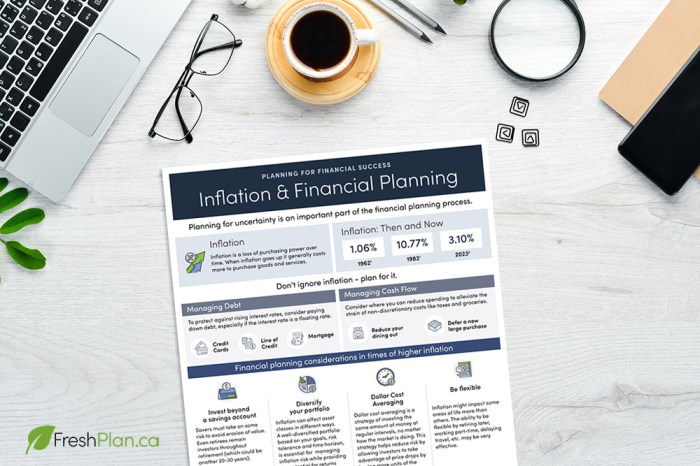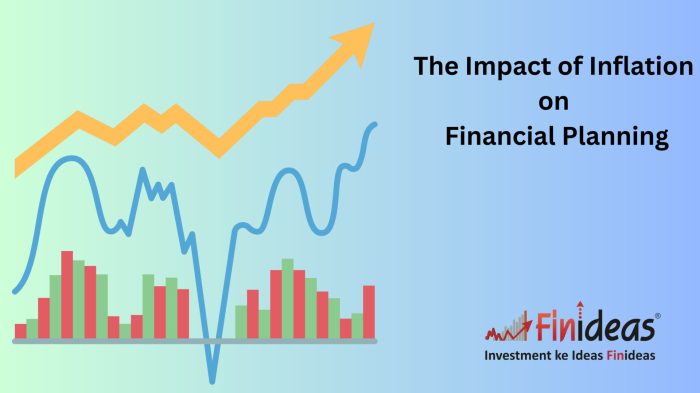
Exploring the intricate relationship between inflation and long-term financial planning, this article delves into the various aspects that individuals need to consider for a secure financial future. From understanding the effects of inflation on savings to exploring strategies to mitigate risks, this piece aims to provide valuable insights for readers navigating the complex world of financial planning.
Introduction to Inflation and Financial Planning

Inflation is the gradual increase in the prices of goods and services over time, resulting in the decrease in the purchasing power of a currency. This means that the same amount of money will buy fewer goods and services in the future than it does today.
When it comes to financial planning, it is crucial to consider the impact of inflation, especially in the long term.
The Impact of Inflation on Savings, Investments, and Retirement Funds
Inflation can erode the value of savings over time, as the interest earned on savings may not keep up with the rising prices of goods and services. This means that if you are saving for a specific goal, such as buying a house or funding your child’s education, inflation can make it more challenging to reach that goal.When it comes to investments, inflation can affect the real rate of return.
For example, if your investment earns a 5% return, but the inflation rate is 3%, your real rate of return is only 2%. This means that your investments may not be growing as much as you think when taking inflation into account.Inflation also impacts retirement funds, as the cost of living tends to increase over time.
If your retirement savings are not growing at a rate that outpaces inflation, you may find that your retirement funds are not sufficient to maintain your desired lifestyle during retirement.
Strategies for Mitigating Inflation Risks

Inflation can have a significant impact on long-term financial planning, but there are strategies that can help mitigate the risks associated with it. One effective way to protect your investments from the erosive effects of inflation is by diversifying your portfolio and incorporating real assets like real estate and commodities.
Investment Strategies to Hedge Against Inflation
- One common strategy to hedge against inflation is to invest in assets that have historically shown a positive correlation with inflation, such as Treasury Inflation-Protected Securities (TIPS) or inflation-indexed bonds.
- Another approach is to invest in dividend-paying stocks, as companies that consistently raise their dividends tend to outperform during inflationary periods.
- Consider investing in growth stocks or sectors that can benefit from rising prices, such as technology or healthcare.
The Role of Diversification in Protecting Against Erosion of Purchasing Power
- Diversification involves spreading your investments across different asset classes to reduce risk. By diversifying your portfolio, you can protect against the erosion of purchasing power caused by inflation.
- Include a mix of stocks, bonds, real estate, and commodities in your portfolio to ensure that you have exposure to different sectors that can perform well in varying economic conditions.
- Rebalance your portfolio regularly to maintain your desired asset allocation and adjust to changing market conditions.
The Importance of Real Assets like Real Estate and Commodities
- Real assets like real estate and commodities have intrinsic value that can help protect against inflation. Real estate investments can provide rental income and potential appreciation, while commodities like gold and silver can serve as a hedge against currency devaluation.
- Consider investing in real estate investment trusts (REITs) or commodity ETFs to gain exposure to these asset classes without directly owning physical properties or commodities.
- Monitor the performance of real assets in your portfolio and make adjustments as needed to ensure that you are effectively combating inflation risks.
Long-Term Financial Planning in a High Inflation Environment
In a high inflation environment, long-term financial planning can present significant challenges for individuals. The erosion of purchasing power over time due to rising prices can affect savings, investments, and retirement plans. It is essential for individuals to adapt their financial goals and strategies to mitigate the impact of inflation and secure their financial future.
Adjusting Financial Goals and Strategies
- Invest in assets that tend to outperform inflation, such as stocks, real estate, and commodities.
- Diversify your investment portfolio to spread risk and capitalize on different asset classes.
- Consider investing in inflation-protected securities like TIPS (Treasury Inflation-Protected Securities) to safeguard against inflation.
- Focus on increasing income streams through side hustles, passive income sources, or career advancement to counteract the effects of inflation.
Importance of Regularly Reviewing and Adjusting Financial Plans
Regularly reviewing and adjusting financial plans in response to changing inflation rates is crucial for long-term financial success. By monitoring the impact of inflation on savings and investments, individuals can make informed decisions to protect their wealth and achieve their financial goals.
Failure to adjust financial plans could result in falling short of desired outcomes and jeopardize financial security.
Impact of Inflation on Retirement Planning
When it comes to retirement planning, inflation plays a significant role in determining the purchasing power of savings and income during retirement. As prices rise over time, the value of money decreases, impacting the ability of retirees to maintain their standard of living.
Impact on Retirement Income and Savings
- Inflation erodes the real value of retirement savings over time, reducing the purchasing power of those savings.
- Retirees relying on fixed-income sources such as pensions may find it challenging to keep up with inflation as their income remains constant.
- Those with investments in low-yielding assets may struggle to generate enough returns to outpace inflation, leading to a decrease in real returns.
Strategies for Mitigating Inflation Risk in Retirement
- Diversifying investment portfolios to include assets that historically outperform inflation, such as equities or real estate.
- Utilizing inflation-protected securities like Treasury Inflation-Protected Securities (TIPS) to safeguard against purchasing power erosion.
- Regularly reviewing and adjusting retirement income strategies to account for inflation and changing market conditions.
Role of Social Security and Pensions
- Social Security benefits are adjusted annually for inflation, providing a reliable source of income that keeps pace with rising prices.
- Pensions with cost-of-living adjustments (COLAs) can help retirees maintain their purchasing power over time, offering a level of protection against inflation.
- Supplementing retirement income with annuities or other sources of guaranteed income can provide a steady stream of cash flow unaffected by inflation.
Global Investing Insight on Inflation
In the global landscape of investing, understanding how inflation rates vary across countries and regions is crucial for effective financial planning. Different economic trends and government policies can greatly influence these rates, impacting investment strategies to mitigate inflation risks.
Analyzing Inflation Disparities
When comparing inflation rates across countries, it’s essential to consider factors such as economic stability, currency strength, and government interventions. For example, emerging markets may experience higher inflation rates due to rapid economic growth and fluctuating currency values. In contrast, developed countries with stable economies tend to have lower inflation rates.
Impact of Global Economic Trends
Global economic trends, such as trade agreements, geopolitical events, and monetary policies, can directly affect inflation rates. For instance, a trade war between major economies can lead to higher import costs, driving up prices and inflation. Investors need to stay informed about these trends to adjust their portfolios accordingly.
Utilizing International Investments as Hedge
International investments offer a way to diversify portfolios and hedge against inflation risks. By investing in assets denominated in different currencies or industries, investors can protect their wealth from the impact of inflation in a single country. For example, investing in commodities like gold or foreign real estate can provide a hedge against inflation in a specific region.
Sustainable Finance and Inflation
Investing sustainably can play a crucial role in protecting your portfolio from the impact of inflation. By aligning environmental, social, and governance (ESG) criteria with long-term financial planning, investors can build a resilient portfolio that can withstand the effects of rising prices.
Integration of ESG Criteria in Financial Planning
- Integrating ESG criteria into financial planning can help identify companies that are better equipped to navigate inflationary environments. Companies with strong sustainability practices tend to have better risk management strategies in place.
- By focusing on ESG factors, investors can select assets that are more likely to maintain their value over the long term, reducing the impact of inflation on their investment returns.
- ESG integration can also lead to a more diversified portfolio, spreading risk across different asset classes and industries, which can provide a buffer against inflation-induced market volatility.
Examples of Sustainable Finance Initiatives
- Green bonds: Investing in green bonds issued by companies or governments to fund environmentally friendly projects can provide a hedge against inflation while contributing to sustainable development.
- Socially responsible investing (SRI): SRI strategies focus on investing in companies that have a positive social impact, such as those promoting diversity and inclusion. These investments can offer inflation protection while aligning with ethical values.
- Renewable energy projects: Investing in renewable energy infrastructure can offer long-term stable returns that are less susceptible to inflationary pressures, making it an attractive option for inflation-resistant investment strategies.
Last Word
In conclusion, the impact of inflation on long-term financial planning cannot be understated. By staying informed, adapting strategies, and seeking diverse investment opportunities, individuals can better prepare themselves for the challenges that inflation poses. Remember, a proactive approach to financial planning is key to securing a stable financial future.
FAQ Section
How does inflation affect retirement planning?
Inflation can reduce the purchasing power of retirement savings over time, making it crucial for retirees to consider inflation when planning for retirement. Strategies such as investing in inflation-protected securities can help mitigate this risk.
Why is it important to review financial plans in response to changing inflation rates?
Regularly reviewing and adjusting financial plans allows individuals to adapt to the impact of inflation, ensuring that their long-term financial goals remain achievable despite changing economic conditions.




